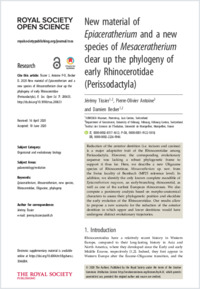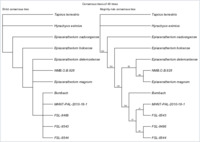New material of Epiaceratherium and a new species of Mesaceratherium clear up the phylogeny of early Rhinocerotidae (Perissodactyla)
- Tissier, Jérémy Jurassica Museum, Porrentruy, Switzerland / Department of Geosciences, University of Fribourg, Fribourg, Switzerland
- Antoine, Pierre-Olivier Institut des Sciences de l’Évolution, Université de Montpellier, Montpellier, France
- Becker, Damien Jurassica Museum, Porrentruy, Switzerland / Department of Geosciences, University of Fribourg, Fribourg, Switzerland
-
2020
Published in:
- Royal Society Open Science. - 2020, vol. 7, no. 7, p. 200633
English
Reduction of the anterior dentition (i.e. incisors and canines) is a major adaptative trait of the Rhinocerotidae among Perissodactyla. However, the corresponding evolutionary sequence was lacking a robust phylogenetic frame to support it thus far. Here, we describe a new Oligocene species of Rhinocerotinae, Mesaceratherium sp. nov. from the Swiss locality of Bumbach (MP25 reference level). In addition, we identify the only known complete mandible of Epiaceratherium magnum, an early- branching rhinocerotid, as well as one of the earliest European rhinoceroses. We also compute a parsimony analysis based on morpho-anatomical characters to assess their phylogenetic position and elucidate the early evolution of the Rhinocerotidae. Our results allow to propose a new scenario for the reduction of the anterior dentition in which upper and lower dentitions would have undergone distinct evolutionary trajectories.
- Faculty
- Faculté des sciences et de médecine
- Department
- Département de Géosciences
- Language
-
- English
- Classification
- Palaeontology
- License
-
License undefined
- Identifiers
-
- RERO DOC 328879
- DOI 10.1098/rsos.200633
- Persistent URL
- https://folia.unifr.ch/unifr/documents/308776
Other files
Statistics
Document views: 166
File downloads:
- Fichier principal: 206
- Supplementary material: 128
- Supplementary material: 90


